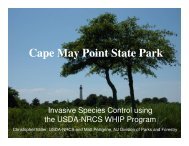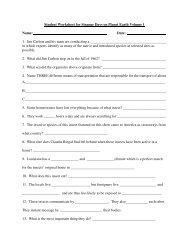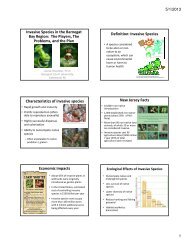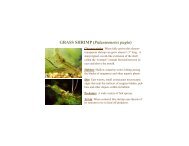Norway Maple (Acer platanoides) Japanese Barberry (Berberis ...
Norway Maple (Acer platanoides) Japanese Barberry (Berberis ...
Norway Maple (Acer platanoides) Japanese Barberry (Berberis ...
Create successful ePaper yourself
Turn your PDF publications into a flip-book with our unique Google optimized e-Paper software.
Status: Exotic.<br />
Purple dead nettle (Lamium purpureum)<br />
Native to: Europe and Asia.<br />
Effects: Common on roadsides, this weed is commonly<br />
found in farm fields that are not currently in use, as<br />
well as in waste lands and near human developments.<br />
Although it doesn’t seem to have strong, negative<br />
ecological effects, planting or spreading this non-native<br />
plant should still be avoided.<br />
Distinctive features: This plant is usually only 4 or 5”<br />
tall, and has square stems and crowded, overlapping,<br />
heart-shaped leaves. It also forms tiny “snap-dragon”-<br />
like purple flowers. The most distinctive characteristic<br />
of Purple Dead Nettle is the purple tinge of the young<br />
leaves at the apex of the stem. It is similar to henbit,<br />
but its leaves have stalks, whereas henbit’s do not.<br />
http://www.missouriplants.com/Pinkopp/Lamium_purpureum_pa<br />
ge.html<br />
Status: Invasive.<br />
Purple loosestrife (Lythrum salicaria)<br />
Native to: Eurasia.<br />
Effects: This plant is a very strong competitor in<br />
natural and disturbed wetlands. It outcompetes and<br />
replaces native grasses, sedges, and other flowering<br />
plants that provide a higher quality source of nutrition<br />
for wildlife. A mature plant can produce 2 -3 million<br />
seeds per year.<br />
http://upload.wikimedia.org/wikipedia/commons/2/24/LythrumS<br />
alicaria.jpg<br />
Distinctive features: This plant can form large clumps<br />
about five feet tall, with each clump forming numerous<br />
showy spikes of reddish purple flowers. Each flower has<br />
five to seven pink-purple petals surrounding a small<br />
yellow center. Its leaves are long and narrow, and attach<br />
closely to the four-sided stem opposite to one another<br />
or in a “whorl”. Purple loosestrife may be distinguished<br />
from similar looking species by its generally larger size,<br />
opposite to whorled leaves, and densely packed flowers.







